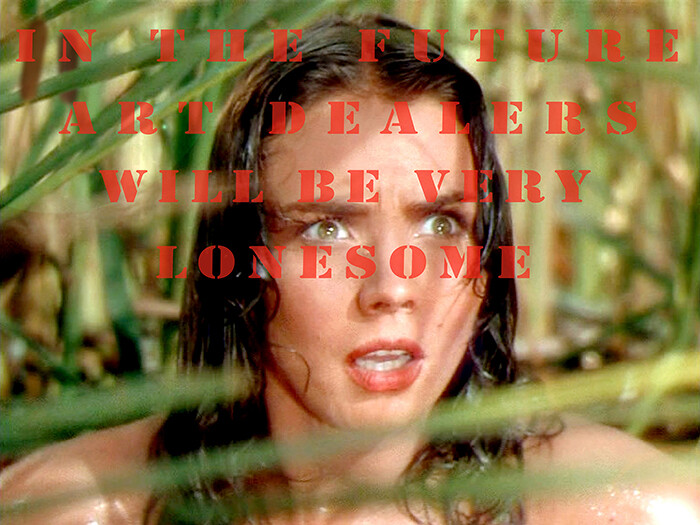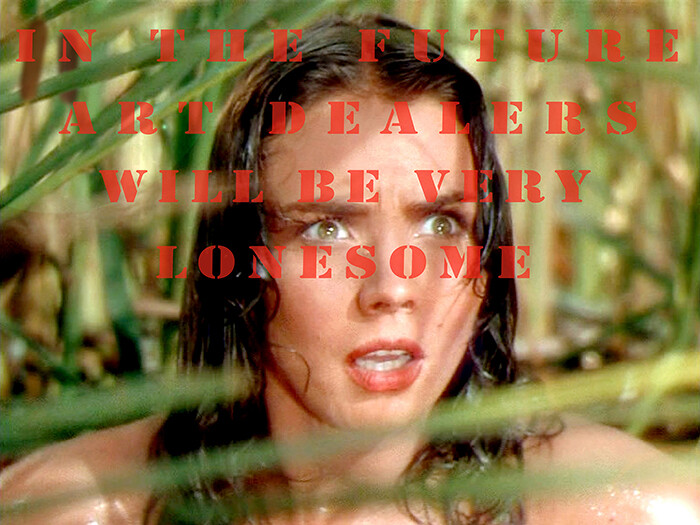Klaus vom Bruch (b. 1952) is something like this Gallery Weekend’s wicked fairy godmother. Even though he and his gallery SASSA TRÜLZSCH were rightfully invited to participate in the event’s tenth anniversary, vom Bruch’s “In the Future …” series (2008–14) casts some rather sardonic prophesies upon the (art) world. In this utopia/dystopia, prospects are pretty grim for everyone. But after a tour around the galleries, you really hope he’s wrong, especially when he posits: “In the future art dealers will be very lonesome.” As in Berlin, it is still the dealers that dig out the treasures of recent art history and stage positions that you don’t see (enough of) in public institutions.
Just take the wonderful Zofia Kulik (b. 1947). ŻAK | BRANICKA made photographic prints from her 1970/71 diploma work, which were originally 35mm slides. Demonstrating the artist’s early and rigorous turn towards an art that takes the body as its material and starting point, this exhibition titled “Instead of Sculpture – Sequences 1968–71” features work made at a time when her native country of Poland was still under communist rule, and so was the art. Or Geta Brătescu (b. 1926) at Galerie Barbara Weiss who, under the rigid Ceaușescu regime in Romania, also resorted to the intimacy of the body and the mundane; however, her paintings and drawings unleash the forces of many a mythological creature at the same time. Sadly, and just as predictably, the works of these two significant figures are among the very few established, female artists on display at the height of Berlin’s gallery season this year, reflecting the art market’s unfortunate status quo.
Thankfully, there was also American artist Lutz Bacher at Galerie Buchholz, whose work looked a bit like a softer Cady Noland, with her assertion of an aggressively male, Go-West-mentality. Bacher’s crude “Bison” sculptures (2012), her “Homer” series (2013) of Greek soldiers off-duty, and “Yamaha” (2010–12), uncannily automated organ music, coalesced into an almost psychoanalytical simulacrum of male behavior—without resorting to a word of Freudian language.
Still, Julian Beck’s drawings and paintings dating to the period 1944–58 at Supportico Lopez were another Gallery Weekend gem. Beck (1925–1985), mostly known for co-birthing New York’s The Living Theatre in 1947, evidently also had a healthy practice in the visual arts. His rather intimately-scaled, and often vibrant and colorful works are clearly infused by Tachism, but, owing to their clothesline-style presentation, look little more dated than last year. ARRATIA BEER, in contrast, introduced the ascetic work of the late Friedrich Teepe (1929–2012) from Osnabrück, an art world hermit who based his sober and serene work from the 1970s and 80s on stretching, folding, and shaping canvases.
This was no doubt the Gallery Weekend of contemporary art’s parents or even grandparents, and it was hard not to feel nostalgic about the urgency or intransigency that characterizes so many of these works. And some of these qualities seemed to have rubbed off on the gallerists as well. While in recent years, resorting to the old boys’ club (albeit always including one or two exceptional women) often looked little more than playing it safe, exhibitions this year seemed a lot more spirited. There was even the odd presentation of video works, which require—as demonstrated by any art fair or market survey—a bit of faith and bravery. But with a classic like American site-specific artist Gordon Matta-Clark (1942–1978), you really can’t go wrong. Galerie Thomas Schulte’s presentation of the 1970s Matta-Clark films, which document his incisive interventions within the urban space and structure, was both an homage to the artist and something like an overview of his work. With Peruvian artist Antonio Paucar, who lives in Berlin, and Belgian artist David Claerbout, Galerie Barbara Thumm and Johnen Galerie ventured, respectively, into more recent work of performance-based or hypno-narrative video art. Carlier|gebauer even risked a themed group show—“Memory Palaces”—a rarity by Gallery Weekend standards, and Galerie Wien Lukatsch had their premises turned into the geo-eclectic worlds of Beninese sculptor Georges Adéagbo (b. 1942), who, though internationally renowned, is not a Berlin household name.
Having said all that, it didn’t feel as if painting ruled, and there was very little that would have fallen into the “over-the-sofa” category. You certainly wouldn’t attach the label “flatware” to Berlin-based Dominik Sittig’s heavy builds with their scabbed and chapped surfaces at Galerie Nagel Draxler or to Brooklyn-based Chris Martin’s glittering collages and hallucinogenic reflections on pop (music) and American abstract art at KOW. And then there was grandmaster Philip Guston (1913–1980), as featured by Aurel Scheibler, who offset Guston’s chewing-gum palette with two darker, somber canvases, The Light (1960) and Winter II (1961). It surely was also the manageable, nearly intimate size of presentations like Guston’s that—compared to many size-matters museum and certainly size-matters-even-more dealer shows—added to the allure and accessibility of these artists, making you feel more like you’re welcomed by family than greeted by imposing ancestors.
So, what were the youngsters up to? Doing what kids do… playing with their gadgets. New York-based artist Hugh Scott-Douglas, for instance, worked around the software that prevents most scanners from reading and digitizing bank notes. He found that many a bill is, when in use, imprinted with mysterious signs or stamps that semiotics simply can’t grasp. (In somewhat shadier economies, they might also function as an ad-hoc communication system. But this is only a guess.) These marks, however, override the anti-scanning software and now form the seemingly abstract, ornamental patterns of Scott-Douglas’s large-format “Chopped Bills” prints (2013) at Croy Nielsen. At Kraupa-Tuskany Zeidler, Katja Novitskova—a participant in the (in)famous “Speculations on Anonymous Materials” exhibition at Kassel’s Fridericianum who currently lives in Amsterdam—takes a similar “Blow Up”-style approach. She looks at the cognitive patterns that rule perception, whether that of humans or intelligent machines. Her exhibition starts with the conspiracy theories that evolve around NASA’s Mars images, which some people tend to over-scrutinize. Yet, instead of analyzing or deconstructing the mechanisms that feed these fantasies, Novitskova adds to the confusion by inhabiting Pattern of Activation (on Mars)(2014), a live video projection of a Martian landscape, with unexpected life forms. (She, in fact, set it up herself in an in-house photography studio, but the viewer has no indication of this.) And at WENTRUP, Florian Meisenberg covers the walls with Photoshop’s transparency grid, which becomes the surface for “Somewhere sideways, down, at an angle, but very close {about:blank}” (2014), his series of raw canvases with sparse, but thick and oily painterly elements. They serve as a backdrop for his smartphone-format screens with videos like Wembley, farewell my Concubine (2013) of (computer) surfaces.
It’s not at all as if the so-called post-internet generation would make the work of the older artists look like bores. Rather, we could imagine that this data-processing-like take on the world might satiate the lingering appetite for the raw and analog, almost DIY approach of a generation that still knows the materiality of 35mm slides and celluloid. This Gallery Weekend certainly had a strong, back-to-the-roots feeling, a longing for the familiar, and the economically sound. And while the attendant social events are under pressure to top last year’s locations (and, admittedly, they do), most galleries were content with their own premises—with the exception of Isabella Bortolozzi. This is a gallerist who simply has a knack for finding the more unusual spaces. She spread her generation-spanning shows across multiple venues (some temporary and semi-public), with Pierre Klossowski’s “Catholic-homoerotic” exorcisms in a picturesquely dilapidated apartment upstairs on Bülowstraße, Seth Price’s conceptual paintings downstairs in a corner-shop-pharmacy-turned-art-paradise (EDEN EDEN), and Wu Tsang’s intense video installation A day in the life of bliss (2014), featuring performer boychild at her gallery’s permanent space on Schöneberger Ufer. So, all in all, this was a very adult celebration of Gallery Weekend’s anniversary, but art world years surely don’t convert to human years.













